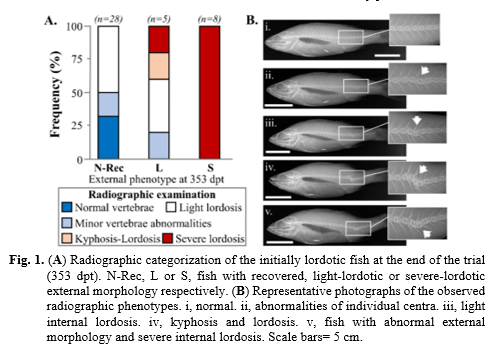RECOVERY OF HAEMAL LORDOSIS IN EUROPEAN SEA BASS Dicentrarchus labrax
Introduction
Haemal lordosis is a frequent vertebral abnorm ality in finfish aquaculture , with significant and variable effects on fish externally morphology ( Fragkoulis et al. 2019, 2021 ). In most of the fish species studied so far, haemal lordosis develops during the late metamorphosis and early juvenile period , mainly due to elevated fish swimming activity (Sfakianakis et al. 2006 , Palstra et al. 2020, Printzi et al. 2021 ). Despite the significance abnormalities for the product quality , it was recently shown that haemal lordosis can substantially recover during the growth of seabream in sea cages (Fragkoulis et al. 2019) .
In the present study we examined whether haemal lordosis may recover in European sea bass , the species where swimming-induced lordosis was first described (Divanach et al. 1997).
Material and Methods
Fifty -six sea bass juveniles (77±6 mm standard length, SL) with lordotic external morphology (dorsally shifted caudal peduncle) were selected from one reared population . All fish were anaesthetised, tagged electronically (FDX-B, Trovan Ltd, USA ), photographed on their left side and returned to the sea cage until the end of the on-growing period (234±16 mm SL). At that stage, fish were anaesthetised, photographed and tag-identified. Subsequently , a representative sample of fish with a recovered and lordotic external morphology was radiographically examined.
Results & Discussion
At the end of the examined period (353 dpt) , the 57% (32 out of 56 ) of the fish with severe lordotic morphology presented normal external phenotype, whereas 7% (4 out of 56 ) presented light lordotic morphology. The rest 36% of the fish (20 out of 56 ) continued presenting a lordotic external morphology . The r adiographic examination of the fish, verified the macroscopically observed lordosis recovery. T he 32% of specimens with recovered external morphology (28 out of 41 ) presented a completely normal vertebral column (Fig. 1Bi), whereas the 18% presented minor abnormalities of individual centra ( Fig. 1Bii) . The rest 50% of the recovered fish presented a light bending of the vertebral column ( Fig. 1Biii).
Concerning severely lordotic fish that turned in to fish with light lordotic external morphology, 40% presented light vertebral bending , whereas 60 % presented either minor abnormalities of individual centra , severe lordosis , or a counterbalancing kyphosis anteriorly to lordosis (Fig. 1 A, 1Bii-Bv). Finally, all fish with severe lordotic external morphology, presented a severe vertebral bending (Fig. 1Bv).
In the present study we showed that the external morphology of lordotic sea bass juveniles may completely recover during the on-growing period . The recorded recovery rate of lordosis in sea bass (57%) is higher than that previously reported for seabream ( 44%, Fragkoulis et al. 2019) . Fragkoulis et al . (2019), assumed that the rearing in the sea cages, might be responsible for the recovery, due to the adaptability of the vertebrae in the less intense water current velocities, compared to conditions in the tanks. Our results do not contradict this hypothesis, since the recovery was observed during the on-growing period. Similarly , our radiographic findings on the anatomy of the lordosis recovery are in total agreement with Fragkoulis et al. (2019), with the same phenotypes observed in both studies. Our results show that lordosis recovery is not species-specific and has to be taken into consideration during the quality control at the end of the hatchery phase. Further morphometric analysis in the future, could provide useful indices for the accurate discrimination between abnormal fish, on the basis of their recovery potential.
Acknowledgments
This study was financially supported by EU (European Maritime and Fisheries Fund (EMFF) and national (Greek) funds (NSRF 2014-2020, call Novelty in Aquaculture, Project No. 5010952) of the Ministry of Rural Development and Food, Greece.
References
Divanach P, Papandroulakis N, Anastasiadis P, Koumoundouros G, Kentouri M (1997) Effect of water currents during postlarval and nursery phase on the development of skeletal deformities in sea bass (Dicentrarchus labrax L.) with functional swimbladder. Aquaculture 156:145-155.
Fragkoulis S, Printzi A, Geladakis G, Katrimpouzas N, Koumoundouros G (2019) Recovery of haemal lordosis in Gilthead seabream ( Sparus aurata L.). Sci. Rep. 9, 9832.
Fragkoulis S, Koumoundouros G (2021) Simple morphometrics for predicting lordosis-induced deviations of body shape in reared Gilthead seabream (Sparus aurata L.). J Fish Dis. 2021; 00:1–3.
Sfakianakis DG, Georgakopoulou E, Papadakis I, Divanach P, Kentouri M, Koumoundouros G (2006) Environmental determinants of hemal lordosis in European sea bass, Dicentrarchus labrax (Linnaeus, 1758). Aquaculture 254:54-64.
Palstra AP, Roque A, Kruijt L, Jéhannet P, Pérez-Sánchez J, Dirks RP (2020) Physiological e ffects of w ater f low i nduced s wimming e xercise in s eabream Sparus aurata. Front. Physiol. 11:610049.
Printzi A, Fragkoulis S, Dimitriadi A, Keklikoglou K, Arvanitidis C, Witten PE, Koumoundouros G (2021) Exercise induced lordosis in zebrafish Danio rerio (Hamilton, 1822). J. Fish Biol. 98:987–994.
